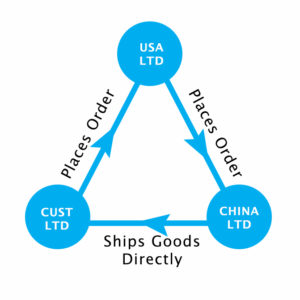Are you a trader with exports and imports to and from different countries? Do you take advantage of foreign-to-foreign shipping? If not, you could soon lose out to your competitors who are doing so.
What is a Foreign-To-Foreign Shipment?
A foreign-to-foreign Shipment also known as F2F shipment, triangular shipment or triangular trading is a transaction involving three parties in three different countries. One of the parties, usually a wholesaler, takes an order from a buyer in a particular country and procures the goods from a supplier located in a different country and arranges to ship the goods directly from the supplier to the buyer without the consignment passing through the country where the wholesaler is situated.
For example, if you are a wholesaler situated in the U.S who buys goods from China and you have a customer in Chile who has placed an order for say, one container of tools. You can buy the container of tools from China and route it directly to Chile without the goods entering the U.S and without revealing the identity of buyer and seller to each other.
What are the Advantages of F2F Shipments?
Though it may sound risky, the advantages of foreign-to-foreign shipments are many:
Shorter Transportation Time
Customs clearance at the U.S ports is a cumbersome process. Moreover, if the container is subject to Customs Border Control’s (CBP) detailed inspection, there will be additional delay for completing the clearance procedures. Triangular shipping helps to avoid this delay. This is especially important for those companies dealing with perishables and other price volatile commodities.
Lower Supply Chain Cost
Foreign-to-foreign shipping reduces supply chain cost by saving on the freight rates and eliminating clearance charges at the U.S port.
Supply Chain Efficiency
In triangle shipping, the complete logistics from the port of loading to the final port of discharge is handled by a single point of contact, i.e., your freight forwarder, hence optimizing the supply chain efficiency.
What are the risks?
The main risk involved for the U.S Company in this type of operation is the identity of the supplier and end customer being exposed to each other, which could lead to the US Company being bypassed in future transactions. However, this can be completely eliminated when the logistics is handled by an experienced and trustworthy freight forwarder.
Process and Documentation
To explain the process, let us assume that Cust. Ltd located at Chile has placed an order with USA Ltd and the goods are shipped directly from USA Ltd.’s supplier China Ltd to Cust. Ltd.

- While executing a foreign-to-foreign shipment, the entire logistics process will be taken care of by USA Ltd.’s freight forwarder through their network of trusted partners.
- The B/L issued to the supplier at the port of loading will have USA Ltd mentioned as the consignee and not the actual buyer – Cust. Ltd.
- China Ltd will then send the complete set of documents including bill of lading, commercial invoice, packing list, Certificate of Origin and any other related documents to USA Ltd via bank or as per pre-agreed arrangement.
- USA Ltd, on receipt of this Bill of Lading, surrenders it with the carrier who then issues a new Bill of Lading in which USA Ltd will be the shipper and the Cust. Ltd will be the consignee. This process is called switching the B/L.
Note that the new B/L is issued only once the old one is surrendered as no shipment can have two sets of B/L out at the same time. - USA Ltd. will have to arrange for the commercial invoice and packing list for Cust. Ltd.
- Certificate of origin and other documents required at the destination are arranged in consultation with the Freight Forwarder.
This procedure remains the same irrespective of whether:
– It is an LCL or FCL shipment
– It is an air shipment or a sea shipment, except that instead of bill of lading, airway bill is the document issued by the carrier.
Tips For Successful Execution of Triangular Shipment
This process can be a little tricky, here are a few tips to ensure your shipment is carried out flawlessly:
Trustworthy and Dependable Freight Forwarder
Your Freight Forwarder will know the whereabouts of your buyer and supplier. They will also know your purchase and selling price. Hence, having a trustworthy forwarder is of prime importance while executing a triangular shipment.
Insurance
Ensure that the insurance is covered for issuance of switch B/L.
Switching B/L
This is the most important process in a triangle shipment. The cargo details in both sets of the B/Ls has to be exactly the same. For every amendment in the B/L, you will have to shell out anywhere between $50-$100. Also, if you are working with a Letter of Credit, every discrepancy in the document will also invite a penalty. Hence, always avail the service of an experienced freight forwarder who gives attention to details while engaging in triangular trading.
Though it may sound complex, triangular trading is an arrangement that traders regularly use. With the assistance of an experienced freight forwarder, the process can be smoothly executed.
Have you ever taken advantage of F2F shipping? If so, share your experience in the comments below!




21 Comments on “Foreign-to-Foreign Shipments: Advantages, Risks, Process and Documentation”
very good information!! not so complicated as other… thanks !
Hi Ashwini – glad you enjoyed the article!
Hi, Very much helpful article, I am involved in F2F trade also. I would like to get in touch for logistic services.
Hi Hardik – thank you for reaching out. We can definitely help, feel free to email us directly to solutions@shiplilly.com our expert team will be more than happy to help you with your requirements.
These tips are all helpful.Thanks for sharing. I will definitely follow all of these. I think that this will definitely help me in my shipping business.
Most easiest way to learn F2F trade operation .
Thanks .
Hello Alif – We are glad you enjoyed our article. Thank you for reading our Blog!
A friend of mine has a shipment business. I think this article will be helpful for him. Thanks for sharing this article. I will share this to my friend as well. Thanks for sharing this.
Hello – We are glad you found our article useful. Thank you for reading us!
Hey dear , Thanks For sharing the article. Keep up the good article
Hello
We are a New York-based export trading company(Start-up), have got an order for a regular supply of OCC#11.
Our supplier is from Turkey, and our process is in the final stage. This article helps us a lot. But we need that such TRUST Worthy Freight Forwarder.
As soon as we get that forwarder, we will start our operation. We have to find out the cost of OCC#11 up to the destination port. The shipping mode would be Port to Port.
So, will you be our that forwarder? We believe if we successfully make at least 4/5 shipments, the order of business will jump at multiple levels. As we have good numbers of buyers for this OCC#11.
Hello Ataul,
We’re glad we are already attending all your requirements. Thank you for contacting us!
hello…
LILLY + Associates
Thanks for the clear explanation…
Aware there are 2 sets of invoice in this F2F shipments. For this case one from China to USA (Invoice A) and the other one from USA to CUST LTD(Invoice B) which definitely carries different value. For export Customs clearance at China (POL) they would declare invoice A while at POD end customer declares Invoice B. Is it necessary for one to declare same customs value at both POL and POD or different in custom value acceptable.
Hello Mogana – Different customs values are acceptable as long as you have the commercial documents (invoice) that match the declared value.
This is useful and valuable. Thanks for sharing this Information.
Excellent article. The highlight is that F2F shipment clearly mentioned. We Maxson global exim pvt ltd extend our special thanks to the valuable information furnished.
we will contact you very soon for our requirement.
Excellent narration, process is very clear.
Our EXIM company is based in Mumbai, India. We are involved in F2F trade also. We would like to get in touch for logistic services. Do you have office in India?
Thanks a lot for the blog. Cleared a lot of concepts. We are exporters based in India. Would love to connect with you for F2F and other freight requirements. Please let us know how to connect.
Thank You.
Hello I’m having to pay a FRF charge of $75 when I would have already paid $75 for ISF. Is there a difference in the charges or am I having to pay twice ?